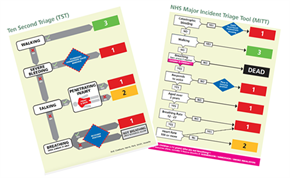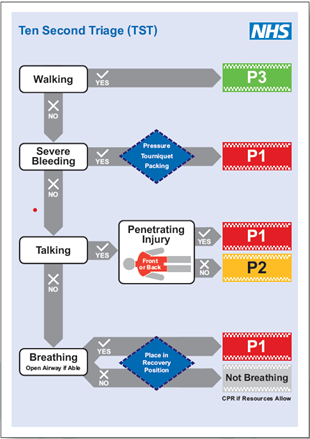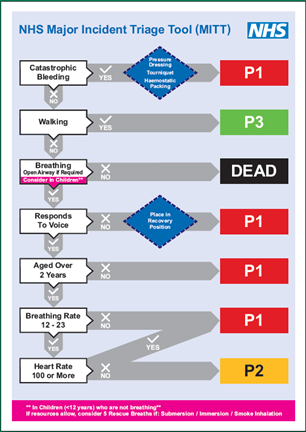
Since July 2013, NHS Ambulance Services have used the NASMeD Triage Sieve algorithm. Following a recent review, with input from scientific experts and experienced practitioners, it was decided that this tool would be replaced with a simplified triage process to be known as Ten Second Triage (TST) and the new Major Incident Triage Tool (MITT).
Ten Second Triage, known as TST, has been trialled and evaluated, to be used by all emergency service responders, and others who are trained in its use, to provide life-saving care at the scene of a Major Incident or a Multiple Casualty Incident.
TST is a quick and effective triage tool and will start to be rolled out from April 2023, with a view that all responders will be using this within a year and that it will replace previous triage tools such as modified and NASMeD Triage Sieves.
There are no physiological metrics to assess. This will significantly speed up the triage process and will facilitate early focus on life-saving interventions of catastrophic haemorrhage and airway.
Ten Second Triage
TST has been designed for use by individuals working as a single ‘operator’ (rather than in pairs as previously taught for other tools).
The algorithm only uses P1, P2 and P3 categories.
Within the TALKING assessment phase, there is an additional parameter for penetrating torso injury.
A positive assessment could indicate a high risk of incompressible haemorrhage, making a casualty who is talking a P1 casualty.
As this tool can be used by any of the responding emergency services there is no ‘Dead’ category within this process, only a new ‘Not Breathing’ category.

The MITT is solely for the use of healthcare responders and the physiological assessment has been revised in line with evidence base from the Modified Physiological Triage Tool (MPTT-24)
The MITT is a single tool for adults and paediatric casualties. It will always be preceded by TST and will be used when casualty numbers mean that it is not possible to remove them immediately from the scene.
MITT can only be instigated once there are sufficient numbers of healthcare staff on scene and will take place at the Casualty Collection Point (CCP) or Casualty Clearing Station (CCS). There must be early re-triage of those identified as “Not Breathing” during TST.
Those children under 2 years of age will be triaged as P1 as they are challenging for clinicians with limited paediatric experience to assess.
All walking casualties will be classified as P3. This is to mitigate against the potential of occult internal injuries being missed during the early phases of a mass/multiple casualty incident.
Major Incident Triage Tool
If MITT is instigated then Triage Cards should be used and TST bands left in situ.
Casualties that have a TST Silver ‘Not Breathing’ band, require urgent clinical review.
The algorithm still uses P1, P2, P3 and Dead categories.
For children under the age of 12 and In circumstances such as:
5 rescue breaths should be considered if resources allow, for those who are not breathing.

This is a major change to the way in which we approach triage and as such will take time to embed. As this is going to be a multi-agency approach, the roll out of training needs to be coordinated and as such NHSE have stipulated that all agencies must move over to this new model of triage by June 2024.
Here in EEAST we will be looking to roll out training to our staff in the coming months, however the purchase of new equipment for our Major Incident packs will determine when this training will be delivered.
Once we have the equipment required to enable us to use the new tools, we will start the training and this will be communicated with everyone.
Published 27th May 2023